Jump to Ingredients – Jump to Method – Jump to Printable Version
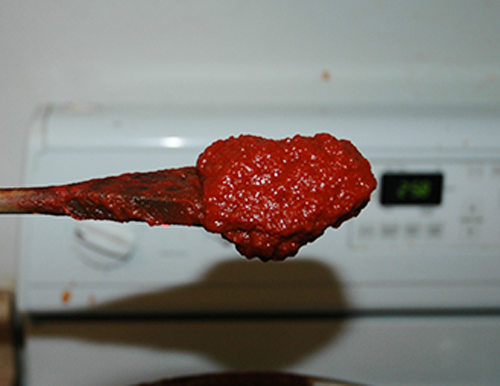 When tomatoes are cooked down, and the liquid is allowed to evaporate, what you are left with is the condensed flavour of the tomatoes. Yes, this is obvious, but I mention it to clear up the misconception that tomato paste is, by nature, bitter. I have read too many recipes that say something to the affect of, “Sugar (or something else must be done) must be added to cut the bitterness (or some call it acidity) of the tomato paste”. It is usually assumed that tomato paste is bitter. It is true that tomato paste is often, far too often, bitter. This, however, is not inevitable. This is the result of using sub par tomatoes in order to make the paste. Do you really think that food companies care if their product is delicious? Certainly not as long as people keep on buying it. Now, there are some brands of tomato paste and other tomato products that are very nice, and I am not saying that there is any reason not to use those. It is defiantly easier to just buy a can of tomato paste than to make it yourself, and to make it yourself you still have to shop around for a great tasting tomato with which to make the paste.
When tomatoes are cooked down, and the liquid is allowed to evaporate, what you are left with is the condensed flavour of the tomatoes. Yes, this is obvious, but I mention it to clear up the misconception that tomato paste is, by nature, bitter. I have read too many recipes that say something to the affect of, “Sugar (or something else must be done) must be added to cut the bitterness (or some call it acidity) of the tomato paste”. It is usually assumed that tomato paste is bitter. It is true that tomato paste is often, far too often, bitter. This, however, is not inevitable. This is the result of using sub par tomatoes in order to make the paste. Do you really think that food companies care if their product is delicious? Certainly not as long as people keep on buying it. Now, there are some brands of tomato paste and other tomato products that are very nice, and I am not saying that there is any reason not to use those. It is defiantly easier to just buy a can of tomato paste than to make it yourself, and to make it yourself you still have to shop around for a great tasting tomato with which to make the paste.
So why make tomato paste at all? Well, one obvious reason would be if someone has a tomato garden, tomato paste is a great way to use up a lot of fresh and delicious vine ripened tomatoes. I would choose that any day over canned tomato paste. Unfortunately for me, I cannot have a tomato garden and good fresh tomatoes in my area are pretty much non existent. I must make my tomato paste from canned tomatoes. What is the point in that? Well, it is merely a matter of personal preference for me. I, as a rule do not buy any form of canned pureed tomato products. I use a lot of canned tomatoes because I need tomatoes for my cooking and as I have stated, good fresh ones are all but non existent here, but when I buy canned tomatoes they are always whole. The reason is because when companies create pureed tomato products, they typically use the worst tomatoes from the harvest. The broken ones, the partially rotten ones, the not quite ripe enough ones, and they do not inspect them very carefully for insects. You are almost guaranteed to have a number of maggots all pureed within your tomato sauce or paste from a can. True, these thing aren’t likely to cause you any harm, but the thought just doesn’t sit well with me. Whole canned tomatoes are inspected more closely for quality and you are far far less likely to come across insects, though neither of these thing are unheard of in canned whole tomatoes. I typically give my whole canned tomatoes a quick once over, and if I notice any blemishes I just pull them off and use the rest of the tomato. I have yet to encounter an insect.
So, if the convenience of canned tomato paste is attractive enough to you that you don’t mind the problems that come along with it then this recipe is not for you. If you have a tomato garden or simply prefer a little more quality control, then read on!
-Ingredients-
Canned or fresh, it doesn’t matter. The most common kind of tomato for this kind of cooking is plum tomatoes, but there is no law against using any other kind. Just whatever you find tastes the best go ahead and use it! Preferably, you will use a tomato with a lot of flesh and not too many seeds, though the seeds will be sieved out so more seeds is merely inconvenient. They won’t actually ruin anything as long as they are sieved out.
I cannot stress enough how important it is to find great tasting tomatoes for this project. When I am testing a new tomato, be it fresh or canned, I often cook it down into paste so that I can taste its essence in its truest form. Everything wrong or right with the flavour of the tomato will come front and center when it is turned into paste. A little bitter? The paste will be quite bitter. A little bland? Bland dull tomato paste. Experiment. You will know when you have found the right stuff. I was really lucky to find these tomatoes. They don’t look like much in those generic looking cans but they taste surprisingly good, and when they are turned into paste, oh wow! It is hard for me not to just eat it straight. I sometimes just use the paste straight on egg sandwiches and in other ways, with no spices or seasonings added. The tomato paste tastes that good all on its own. With a tomato paste with such a pleasing flavour it will definitely add some magic to your cooking.
Use as many tomatoes as you wish. I tend to make batches with around 6 cans worth of whole tomatoes. Realize the more you make at a time the longer it will take, and you will want to have a pretty large stock pot if you are going to make much more than this at once.
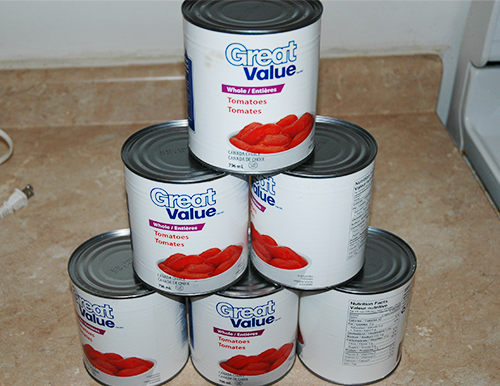 Yeah, only one ingredient this time.
Yeah, only one ingredient this time.
-Method-
If you are using fresh tomatoes, you will want to blanch and peel them.
Process the tomatoes in a blender until completely liquified.
Sieve out the seeds and put the liquified tomatoes into a large stock pot.
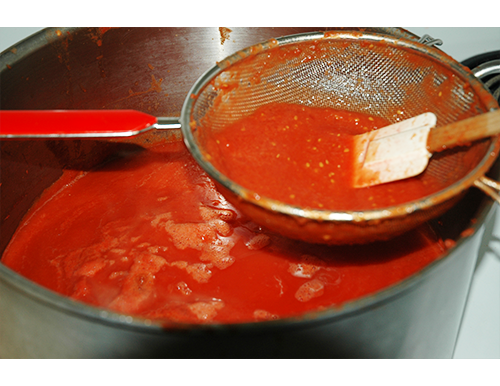 Bring the heat up and let the tomatoes come to a boil briefly. They might spit so monitor the pot and stir as needed to keep things calm. Once the tomatoes are all nicely heated and have boiled for at least a few seconds bring the heat down to maintain a slow steady simmer. You should always see a little bit of steam escaping the pot or else the heat is too low. Unlike simmering water where you look for little bubbles to occasionally break the surface, simmering tomatoes, at least in the beginning, looks like foam forming on the surface. In the picture the foam is forming in a circle because that is directly above where the burner is. This is an extremely wide stock pot.
Bring the heat up and let the tomatoes come to a boil briefly. They might spit so monitor the pot and stir as needed to keep things calm. Once the tomatoes are all nicely heated and have boiled for at least a few seconds bring the heat down to maintain a slow steady simmer. You should always see a little bit of steam escaping the pot or else the heat is too low. Unlike simmering water where you look for little bubbles to occasionally break the surface, simmering tomatoes, at least in the beginning, looks like foam forming on the surface. In the picture the foam is forming in a circle because that is directly above where the burner is. This is an extremely wide stock pot.
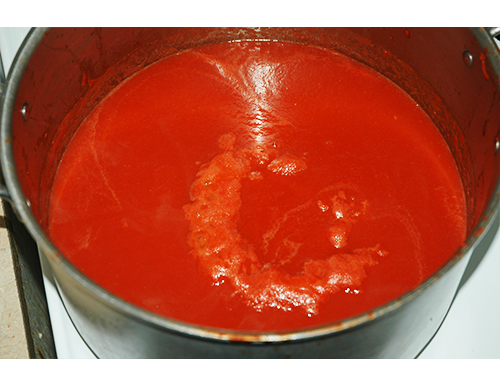 You do not have to babysit the pot but just check on it every 20 or so minutes to make sure that there is a still a nice low simmer going on and to give it a stir, making sure to scrape the bottom, in order to prevent burning.
You do not have to babysit the pot but just check on it every 20 or so minutes to make sure that there is a still a nice low simmer going on and to give it a stir, making sure to scrape the bottom, in order to prevent burning.
Depending on how much you are making and the size of your pot, as well as exactly how hot you have the heat set, this will take varied amounts of time. I got to the point in the picture below after about three hours.
A lot of people would stop at this point since the tomatoes are quite thick and somewhat pasty. I wanted to give you an idea of the consistency and it is hard to do so with stills but I pushed all the tomatoes away from the center of the pot as possible. This is as big a hole as I could create before it filled itself back in. You want to get the paste so thick that it holds its shape much better than this.
When they get to this point I like to turn up the heat and stir constantly in order to blast away most of the remaining water. You will find that you can turn up the heat very high and they will no longer spit. They won’t even burn very easily, especially if you keep stirring them. Now, this step is optional, you can just keep simmering at a very low heat, but I find that doing this at this point shaves off about an hour of cooking time.
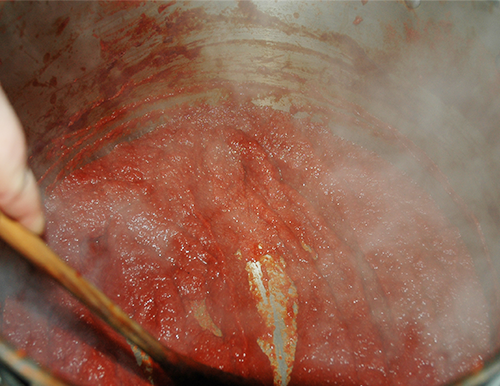 Now it is tomato paste. It is now a semi solid that holds its shape very well. You can see how much more of the bottom of the pot I can expose by trying to move the paste from the center.
Now it is tomato paste. It is now a semi solid that holds its shape very well. You can see how much more of the bottom of the pot I can expose by trying to move the paste from the center.
 On measuring you can see that we are left with about 5 cups of rich thick tomato paste. This, from 6 cans of whole tomatoes.
On measuring you can see that we are left with about 5 cups of rich thick tomato paste. This, from 6 cans of whole tomatoes.
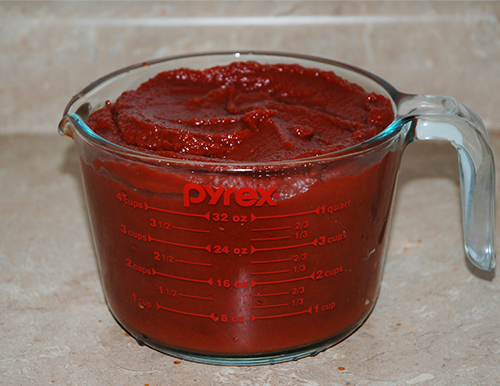 Now the tomato paste is ready to be used, or stored. I would not hold it in the refrigerator for much longer than 4 days. I usually freeze it in ice cube trays. An easy way to fill the trays is to pour the paste into a bag and cut off the corner. Then simply pipe it into the tray wells. You could just spoon it in but I find that I make less mess this way.
Now the tomato paste is ready to be used, or stored. I would not hold it in the refrigerator for much longer than 4 days. I usually freeze it in ice cube trays. An easy way to fill the trays is to pour the paste into a bag and cut off the corner. Then simply pipe it into the tray wells. You could just spoon it in but I find that I make less mess this way.
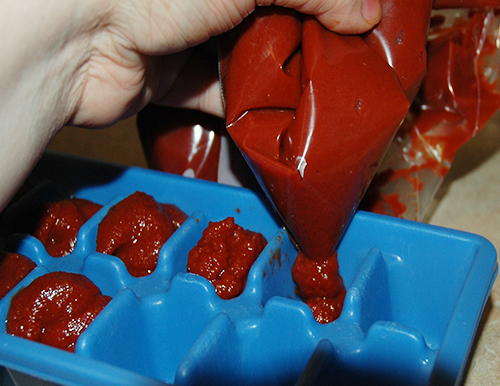 As you can see I was able to make 49 cubes out of this batch. Each of those cubes are about two tablespoons.
As you can see I was able to make 49 cubes out of this batch. Each of those cubes are about two tablespoons.
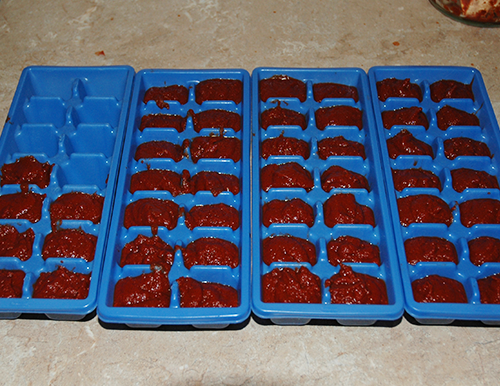 Once they are frozen solid, I move them to a large freezer bag. Stored this way they will last around 4 months before freezer burn starts to affect the flavour.
Once they are frozen solid, I move them to a large freezer bag. Stored this way they will last around 4 months before freezer burn starts to affect the flavour.
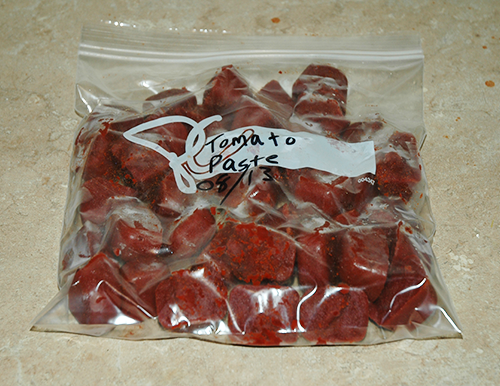 Now you can use them for any recipe calling for tomato paste, for quick and easy sauces, or just to throw a few into whatever you are cooking, if a bit of tomato flavour is desired.
Now you can use them for any recipe calling for tomato paste, for quick and easy sauces, or just to throw a few into whatever you are cooking, if a bit of tomato flavour is desired.
-Printable Version-
TOMATO PASTE
Ingredients:
Tomatoes
Method:
1. If using fresh tomatoes, blanch and peel them. Blend the tomatoes until liquified
2. Sieve out the seeds and put the liquified tomatoes into a large stock pot.
3. Bring to a low boil just to get everything hot and then turn the heat down to allow them to maintain a low simmer.
4. Stir every 20 minutes or so, scraping the bottom of the pot to prevent burning.
5. Depending on various factors it will take different amounts of time, but generally it will take a few hours to condense the tomatoes sufficiently. At any point the heat can be turned up as long as you are willing to stay with the tomatoes and stir constantly. This will greatly speed the process. Also, it is much easier to let them cook on a high heat once they have condensed beyond the thickness of typical tomato sauce. At this thickness they will not splatter.
6. When the paste is so thick that it holds its shape well, and it does not behave like a liquid anymore, the paste is done. Use as needed in recipes, store in the refrigerator for about 4 days, or freeze for up to 4 months.

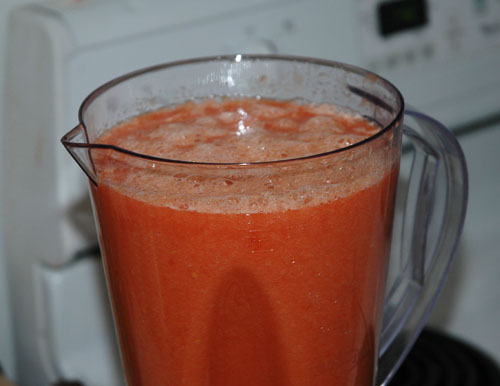
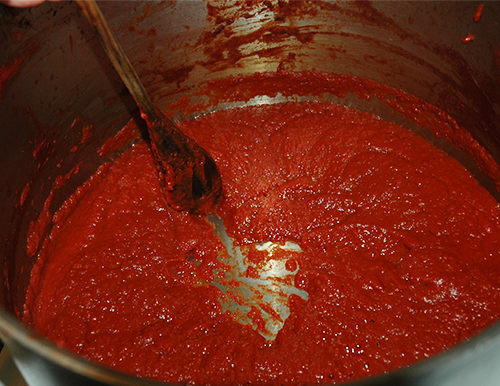
Pingback: Halupkies | The Cooking Geek()